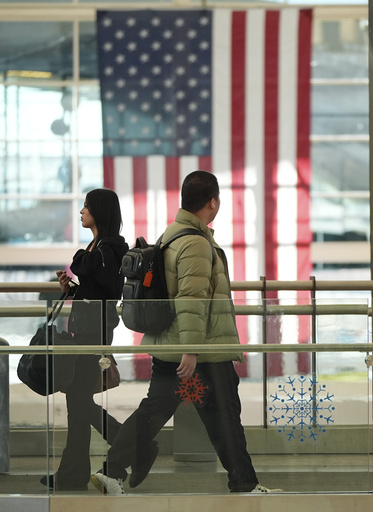
WASHINGTON — American Airlines temporarily halted flights across the country on Tuesday due to a technical issue, coinciding with a surge in holiday travel and impending winter weather that could further complicate travel plans for those flying or driving.
The Federal Aviation Administration (FAA) issued a national ground stop on American Airlines flights after the airline requested it, citing a malfunction with its flight operating system (FOS). This issue was attributed to technology from one of its suppliers. Regulation authorities granted clearance for the planes to resume operations about an hour later. As a result of the situation, numerous flights were delayed at the airline’s main hubs, leading to a troubling statistic where only 36% of the airline’s 3,901 domestic and international departures were on time, with 51 flights ultimately canceled.
According to Dennis Tajer, a representative for the Allied Pilots Association, the pilots were informed of the FOS outage at 7 a.m. Eastern time. The FOS encompasses various operational aspects of the airline, including dispatch, flight planning, passenger boarding, and the aircraft’s weight and balance information. While there have been instances of partial system failures before, a complete outage is rare, Tajer noted.
After lifting the ground stop, there were reports of some travel disruptions, but nothing out of the ordinary for a busy travel day, Tajer indicated. He mentioned that they were monitoring the situation for any potential fallout, such as staffing shortages. However, customers took to social media to voice their frustrations about delays that led to missed connecting flights. Many were seeking clarity on whether American Airlines intended to hold connections for passengers, and several lamented the lack of support they received from airline personnel.
A Florida real estate agent, Bobby Tighe, expressed disappointment after his American Airlines flight was delayed multiple times, causing him to miss a family Christmas Eve gathering in New York. Faced with the choice of either arriving in Westchester, New York, on Christmas Day or taking an alternate route to Newark, New Jersey, Tighe decided on the latter option. He remarked that his girlfriend was having a similar experience traveling from Dallas to New York.
Cirium, an aviation analytics firm, noted that despite the delays, the majority of flights still departed within two hours of their planned times, with 39% arriving on schedule. The hubs in Dallas-Fort Worth, New York’s Kennedy Airport, and Charlotte, North Carolina, saw the most significant delays, while areas such as Washington, Chicago, and Miami reported considerably fewer troubles.
FlightAware, a tracking service, documented the delays of 4,058 flights that either entered or exited the United States, resulting in 76 cancellations. On Tuesday morning, American Airlines flights were not recorded as delayed, but by the afternoon, reports showed that 961 American flights had been delayed.
As travel frustrations mounted, weather across the Pacific Northwest was expected to bring significant rain and snowfall, which would likely last through Christmas Day. Additionally, thunderstorms and showers were appearing in the South, and the Mid-Atlantic area saw reports of freezing rain near Baltimore and Washington, with snow accumulating in New York.
The holiday travel period is generally stretched over several weeks, which tends to lessen the peak traffic compared to Thanksgiving. However, the continuous flux of hectic travel days can exert pressure on flight crews. Disruptions, such as a winter storm or a system failure, can quickly escalate into more widespread travel chaos, a phenomenon that has kept airlines on high alert. Last year’s disruption at Southwest Airlines, which left two million passengers stranded, illustrates the significant impact of such failures during peak travel times.
This holiday season marks the first since the enforcement of a Transportation Department regulation requiring airlines to provide automatic cash refunds for significant flight cancellations or delays. Although many air travelers have been eligible for refunds, they previously needed to request them. Passengers are still advised to inquire about rebooking, as finding last-minute flights with alternatives during the peak times can often be costly.
An American Airlines spokesperson indicated that the day in question wasn’t among the busiest, with roughly 2,000 fewer flights than peak days, giving the airline some leeway in mitigating delays. The ground stop coincided with the anticipated travel surge, as millions prepared to travel over the next week. The Transportation Security Administration projects screening around 40 million travelers between now and January 2, expecting the busiest travel days to be Thursday, Friday, and Sunday.
According to AAA, around 90% of holiday travelers using long-distance transportation will opt for driving. A spokesperson for AAA noted that even though airline travel is currently high, most holiday travelers tend to rely on vehicles for transportation. The current gasoline prices are comparable to last year’s rates, with a national average recorded at $3.04 per gallon, which is down eight cents from a year ago. Electric vehicle charging rates hover around 35 cents per kilowatt hour, although they vary by state.
Transportation data firm INRIX warns that travel times on highways nationwide may experience up to a 30% increase over normal levels during the holiday season, especially with expected heavy traffic on Sunday. Major metropolitan areas, including Boston, New York City, Seattle, and Washington, are predicted to see the most severe delays.

